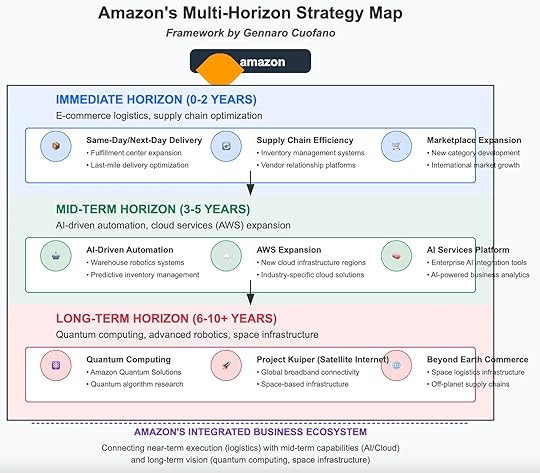Amazon’s Multi-Horizon Strategy Map: From Logistics to Space Infrastructure

Amazon’s rise is often told as a story of relentless e-commerce growth and customer obsession. But the deeper truth is that Amazon has mastered multi-horizon integration: executing in the short term with brutal efficiency, while layering in mid-term bets that became profit engines (AWS), and planting long-term seeds in frontier technologies like quantum computing and space infrastructure.
The Multi-Horizon Strategy Map makes clear that Amazon’s playbook is not about sequential moves, but about building reinforcing horizons where each layer funds and strengthens the next.
Immediate Horizon (0–2 Years): E-Commerce Logistics and Supply Chain OptimizationAmazon’s immediate horizon is its foundation: efficient logistics, rapid fulfillment, and supply chain mastery. While AWS and Prime drive profits, it is the relentless execution in this horizon that sustains Amazon’s consumer dominance.
Key initiatives include:
Same-Day/Next-Day DeliveryAmazon continues to expand fulfillment centers, automate last-mile delivery, and experiment with drones and autonomous vehicles. Speed is not just a feature — it’s a competitive moat that drives customer loyalty.Supply Chain Efficiency
Amazon invests in inventory management systems, predictive demand forecasting, and AI-driven vendor management platforms. These tools allow Amazon to operate at scale without drowning in complexity.Marketplace Expansion
By onboarding millions of third-party sellers, Amazon amplifies its product catalog without carrying proportional inventory risk. International expansion further compounds this effect, cementing Amazon’s status as a global retail backbone.
The immediate horizon is Amazon’s cash engine and credibility builder. It keeps the consumer base locked in and funds the audacious bets in the horizons that follow.
Mid-Term Horizon (3–5 Years): AI-Driven Automation and Cloud ExpansionThe mid-term horizon is where Amazon converts operational scale into technological dominance.
Key initiatives include:
AI-Driven AutomationAmazon is automating warehouses with robotics and predictive inventory management. These systems reduce labor costs, speed fulfillment, and generate proprietary datasets — reinforcing both e-commerce and AWS.AWS Expansion
Amazon Web Services is the crown jewel of Amazon’s mid-term horizon. By building new infrastructure regions and vertical-specific solutions (healthcare, government, finance), AWS deepens enterprise stickiness and captures global digital transformation.AI Services Platform
Amazon is embedding AI directly into its cloud offerings, from machine learning APIs to generative AI services. This positions AWS as not just infrastructure, but a complete platform for enterprise AI adoption.
The mid-term horizon is Amazon’s profit engine. AWS delivers the margins that consumer retail lacks. More importantly, it creates the infrastructure backbone that Amazon can leverage for even bolder long-term bets.
Long-Term Horizon (6–10+ Years): Quantum, Space, and Frontier InfrastructureAmazon’s long-term horizon is where ambition outpaces most corporate imagination. Here, the company is building frontier infrastructure — technologies that may not pay off for a decade, but that could define the next industrial era.
Key initiatives include:
Quantum ComputingThrough Amazon Braket and quantum algorithm research, Amazon is positioning itself as a gatekeeper for enterprise quantum adoption. Quantum capabilities could eventually be woven into AWS, creating a next-generation computational moat.Project Kuiper (Satellite Internet)
Amazon is investing heavily in satellite broadband to compete with SpaceX’s Starlink. Beyond connectivity, Kuiper strengthens AWS by expanding reach into emerging markets, rural areas, and eventually, space-based commerce.Beyond Earth Commerce
In the furthest horizon, Amazon envisions supply chains extending into space: logistics infrastructure for off-planet industries, asteroid mining, or space-based data centers. While speculative, this horizon reflects Amazon’s philosophy: infrastructure first, commerce follows.
The long-term horizon is Amazon’s survival hedge. If commerce and cloud commoditize, Amazon still owns the deepest layers of future infrastructure.
Amazon’s Integrated Business EcosystemAmazon’s horizons are not siloed; they are woven into a single system:
Immediate horizon (logistics) ensures Amazon’s consumer dominance and generates massive operational data.Mid-term horizon (AWS + automation) monetizes that data, delivers high margins, and provides enterprise infrastructure.Long-term horizon (quantum + space) builds new infrastructure layers that AWS and e-commerce can eventually ride on.Amazon’s genius is in how these horizons reinforce each other: logistics → cloud → frontier infrastructure. Each horizon expands the surface area of the next, creating a compounding effect across decades.
Risks and ChallengesWhile Amazon’s horizons look seamless, each layer faces structural risks:
Immediate horizon risks: Rising labor costs, regulatory scrutiny on anticompetitive behavior, and environmental concerns about rapid delivery.Mid-term horizon risks: Fierce cloud competition (Microsoft, Google), AI commoditization, and political constraints on global data sovereignty.Long-term horizon risks: Kuiper may lag SpaceX; quantum computing timelines remain uncertain; space logistics could prove commercially premature.The question is not whether Amazon can build these technologies, but whether it can commercialize them faster than competitors or regulators can constrain them.
Strategic LessonsInfrastructure-first strategy compounds advantageAmazon always builds infrastructure before monetizing it. Fulfillment centers before Prime, cloud before AI, satellites before global connectivity.Horizons are stacked, not sequential
Amazon doesn’t wait for one horizon to finish before starting another. Instead, it overlaps them, ensuring continuity of growth and compounding.Profit pools fund frontier bets
Retail funds AWS; AWS funds Kuiper and quantum. Each profit engine subsidizes the next strategic horizon.Narrative as capital magnet
Amazon uses long-term visions — from space commerce to AI platforms — to attract investors and talent who want to build the future, not just run warehouses.Conclusion
Amazon’s Multi-Horizon Strategy Map reveals a company that plays not just in markets, but in time horizons.
In the short term, Amazon dominates logistics and e-commerce.In the mid term, AWS and automation create unmatched infrastructure moats.In the long term, Amazon seeds frontier bets in quantum, space, and post-planetary commerce.The brilliance of Amazon’s strategy lies in its integration. Each horizon reinforces the others, ensuring survival in the present, dominance in the medium term, and relevance in the far future.
This is not simply strategy — it is time arbitrage at scale. Amazon monetizes today while building tomorrow, ensuring that when the future arrives, it is already positioned at the center of it.

The post Amazon’s Multi-Horizon Strategy Map: From Logistics to Space Infrastructure appeared first on FourWeekMBA.



